Replace traditional automotive electronic passive protection devices with active high-voltage transient protectors
Most automotive electronic systems require overvoltage, reverse battery connection, and transient protection. The use of active protection devices in these protection circuits can achieve many advantages such as low power consumption, optimal operating voltage threshold, lower device cost, and lower quiescent current. This article discusses in detail the advantages of active solutions over traditional protection circuits.
Various electronic and electromagnetic interferences inside and outside the automobile often put the automobile electronic equipment in a dangerous working condition, reduce the performance of the electronic equipment, and may cause malfunction or even damage. The most serious disturbances—large-scale forward and reverse overvoltages and transients—are mostly caused internally by the automotive electronic system or are caused by improper (wrong) operation.
In automotive electronics networks, electronic control units (ECUs) are interconnected by wiring harnesses, and most ECUs are powered by the car battery directly or through start switches. Even in normal operation, there will be electrical interference and high-frequency effects, conducted through the wiring system, and eventually coupled or radiated interference to the on-board electronic equipment. Sources of interference include starting systems, AC motors, load switching, switching jitter, and "load dumping" (that is, the voltage generated when the DC motor is cut off during operation).
The most destructive of these surges is "load dumping" (Figure 1), which occurs when the engine is running and disconnects the battery while the AC motor is charging the battery. The amplitude of the transient voltage generated depends on the speed of the AC motor when disconnected and the magnitude of the field excitation. This surge process may last for hundreds of milliseconds, producing a voltage above 100V, with potentially fatal effects on semiconductor circuits. 
Figure 1. Typical load dump surge waveform: a) no suppression; b) suppression provided.
Another risk is the "dual battery" voltage that exists during the start-up process. At this time, the cable is jumped to another set of 24V network system car batteries, and the 12V system is finally turned on with the 24V battery. Let's consider another situation. When starting the engine, especially in cold weather, the battery is not fully charged, the oil becomes very viscous, the engine needs to provide more torque, therefore, the battery needs to provide more current, A larger current load will cause the power supply voltage to fall from the nominal 12V to below 5V. This drop will last for tens of milliseconds, causing the electronic system to hang for a short time (Figure 2). Once the engine is started, the voltage will return to the nominal value. 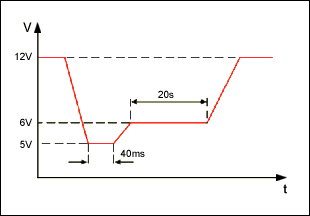
Figure 2. Typical voltage waveform of a car during cold start
Another factor worth noting is that when the battery is connected incorrectly, automotive electronics must be able to withstand the reverse voltage of the battery (for example, -14V).
The above abnormal conditions prompt designers to choose appropriate protection measures to avoid the impact of power failure. Analysis shows that the load dump pulse is the most powerful type of interference. In order to avoid the destruction of electronic circuits by such pulses, there are currently two protective measures:
In all automotive AC motors, a center voltage clamp is used (center load dump suppression, Figure 1b). Provide a protection circuit for each ECU. The system still needs a second-level suppression circuit to filter out low-energy pulses on the circuit board, such as positive and negative transient voltages and spikes caused by the battery's instantaneous reverse connection. These pulses are usually filtered by small-sized large-capacitance capacitors, reverse protection diodes, or inductances connected in series with TVS or variable resistors.
Central load dump suppression is usually achieved by the internal clamping circuit (diode) of the alternator, which is used to absorb the load dump energy and withstand the battery voltage at startup. Despite the clamping measures, if the clamping voltage is set above the maximum starting voltage, the purpose of clamping will not be achieved, and the car voltage will still be as high as 36V.
Those automotive electronic systems that do not have a central load dump suppression function must use local protection measures to suppress load dump interference signals. Generally, a protection circuit is added inside the ECU away from the connector end. Many such protection measures are required inside the entire car. Too many components will lead to increased leakage current and overall cost. On-board load dump protection circuits usually use TVS diodes (similar to Zener diodes), variable resistors, and suppression filters. These components should be connected to the power supply.
Various traditional on-board protection circuits are given below.
There are several types of devices that can be used for overvoltage clamping at the board level.
Avalanche diodes (similar to Zener diodes, Figure 3) are clamping devices that can suppress all voltages that exceed their breakdown. They are able to absorb higher energy and protect electronic circuits from damage due to peak voltage and load dump. These diodes have fast turn-on and slow turn-off characteristics. Compared with other overvoltage protection devices (such as variable resistors), avalanche diodes respond faster to overvoltage events. Its performance index will not decrease with the extension of service life and the increase of the number of transient voltage effects. Near its breakdown voltage, the avalanche suppression diode has a large leakage current. Such diodes are usually expressed as Transil®, TransZorb® or simply TVS diodes. 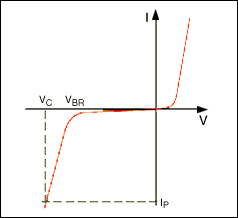
Figure 3. Transient voltage suppressor characteristics (VBR = breakdown voltage, VC = clamping voltage corresponding to peak pulse current IP).
Variable resistance is voltage-dependent resistance (VDR). Correspondingly, the resistance of this non-linear resistance will decrease rapidly after a certain voltage (Figure 4). When clamping positive and negative voltages, its function is similar to back-to-back Zener diodes. It can withstand relatively high current and energy with a small package size and low cost, but when the voltage is close to the clamping voltage, the leakage current is large. The clamping voltage also increases significantly with increasing current. Variable resistors will be affected to a certain extent when they are repeatedly subjected to surge shocks, and usually have a higher "clamp voltage". Compared with TVS diodes, these factors will significantly reduce their response speed. 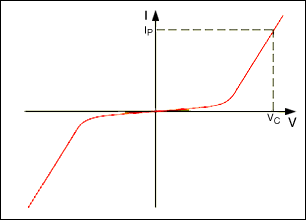
Figure 4. Typical variable resistor characteristics (VC = clamping voltage corresponding to peak pulse current IP)
A simple and cost-effective protection circuit is to connect the load in parallel with a clamping circuit (such as a TVS diode) and add a fuse before the capacitor (Figure 5). This circuit allows the ECU to provide protection to the system under transient overvoltage and load dump conditions that are higher than the breakdown voltage of the TVS diode (D1). When a negative transient voltage or a stable reverse voltage occurs, the TVS conducts forward, thereby clamping the negative voltage at its turn-on voltage (for example, -1V) to provide protection for subsequent circuits. For negative transient voltages with lower energy, for example, overvoltages introduced by relays or solenoid switches, can be filtered by the capacitor (ClowE). If the forward or reverse overvoltage condition is maintained continuously, the fuse will blow. 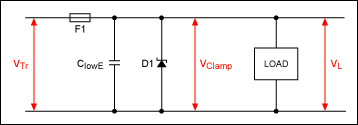
Figure 5. Simple overvoltage protection circuit using filter capacitors, transient suppression diodes and fuses
In order to avoid replacing the fuse in the inaccessible ECU, or to ensure the continuous operation of the ECU, other technologies must be adopted, such as additional series protection. The circuit in Figure 6 protects the ECU from battery reverse connection and transient negative voltage (D2), positive overvoltage pulses (load dump and low energy transient voltage) higher than the breakdown voltage of the TVS diode (D1). The reverse peak voltage of the selected diode D2 must be greater than the maximum value of possible negative pulses. 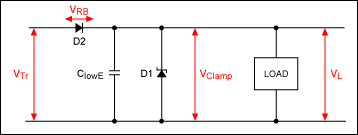
Figure 6. Replacing the fuse in Figure 5 with a diode. This circuit not only provides overvoltage protection but also provides negative transient voltage protection and reverse battery protection.
Considering its small size, low cost, and high power dissipation capability, variable resistors are often used in systems that have strict requirements on the board area and subsequent circuits have a certain tolerance for forward and reverse overvoltages. The circuit shown in Figure 7 can provide effective overvoltage pulse protection (positive and negative transient voltages, the voltage is higher than the breakdown voltage of the variable resistor) to the subsequent circuit. Capacitors help filter out low-energy positive and negative transient voltages. 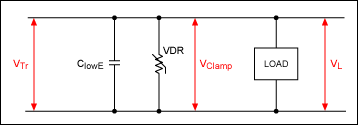
Figure 7. When the board area is limited and overvoltage protection is needed for subsequent circuits, the TVS diode can be replaced with a variable resistor (VDR in the example) as long as the overvoltage pulse (positive or negative transient pulse) is high Due to the breakdown voltage of the variable resistor, when a positive or negative overvoltage occurs, the subsequent circuit must have a certain capacity.
All the above circuits have their own advantages and disadvantages. The circuit shown in Figure 5 is a simple transient protection circuit, which contains only a TVS tube, a filter capacitor and a fuse. For TVS diodes with on-state voltage, this voltage is usually twice that of the battery at startup (often> 26V for more than 1 minute). Otherwise, if the TVS is not properly selected, the TVS tube will be turned on at a lower voltage, and then it will burn out due to continuous power dissipation.
Because the VI characteristics have limited the slope of the current change above the breakdown voltage, the TVS diode also has a certain internal resistance, which will cause the clamping voltage to rise due to the higher current. For example, a 28V TVS tube (such as SMBJ28) will cause the voltage of the subsequent circuit to reach 45V when a load dump occurs. In this case, the subsequent circuit used must be able to withstand 45V (Figure 3). Obviously, this will complicate the selection of subsequent ECU circuit components, and these circuits can usually only work at the upper limit of the car's nominal operating voltage (about 17V). High-voltage semiconductor devices or other components are expensive, which increases the cost of the ECU and occupies valuable circuit board space.
In order to reduce the maximum overvoltage value as much as possible, it is necessary to select a TVS tube with a breakdown voltage close to the highest voltage in a steady state (for example, a starting voltage). This may cause a large leakage current when the breakdown voltage is approached (even at the nominal voltage of a 12V car). When the automotive engine stops working, this leakage current makes it difficult for ECU designers to meet the OEM (equipment manufacturer) requirements for low quiescent current.
Under normal operating conditions, the diode (D1) in Figure 6 shows a voltage drop of> 0.7V, which will cause two problems:
For high current applications, such as automotive anti-lock braking systems, the current consumed can easily exceed 10A. For example, a diode with a voltage drop of 1V in the system will cause a power consumption of 10W. On a circuit board of limited size, it is almost impossible to dissipate such a large amount of power. Using single or double Schottky diodes can alleviate this problem in some applications. Assuming a voltage drop of 0.5V, at a load current of 10A, the power dissipation of the dual Schottky diode is 5W. This is still an unacceptable power consumption, designers have to use a large-size heat sink.
As mentioned above, the diode voltage drop itself will have a certain negative effect. For example, in a 14.4V audio system, the maximum output power depends on the maximum speaker drive voltage that can be obtained. In order to avoid reverse battery connection, a diode will be added to the power supply in the system, which may cause a voltage drop of 1V, causing an output power loss of about 8.4dBW (for a 2Ω bridge speaker).
When the car starts in a cold environment, the ECU must be able to work in a low-voltage state (Figure 2). Any unnecessary voltage drop will affect the system operation. During cold start, the input voltage specified by the car manufacturer is 5.5V or even lower. The voltage drop of the diode used to prevent the reverse connection of the battery will occupy a large margin. For example, the car battery voltage drops to 5.5V at the input connector of the ECU, minus the 0.7V voltage drop of the reverse protection diode of the battery, and the actual voltage supplied to the circuit is only 4.8V.
If the 5V microcontroller is powered by a linear voltage regulator with a voltage difference of 500mV, then the microcontroller can obtain a power supply voltage of only 4.3V, which cannot support its normal operation, it may cause it to enter a reset state and lose memory data Or cause the entire ECU to crash. The GPS navigation system is a typical example: enter the destination address before the car starts, the system must ensure that no data will be lost during the cold start process.
For applications that include variable resistors as shown in Figure 7, the board area is usually very strict. Like the TVS tube, the clamping voltage of the variable resistor is determined according to the highest steady-state DC voltage of the specific application. However, when the voltage is higher than the breakdown voltage, the VI characteristic curve of the variable resistor is much slower than that of the TVS diode (Figure 4). Therefore, the variable resistor will make the subsequent circuit withstand higher voltage than the TVS tube, thereby increasing the device cost, package size and circuit board space of the subsequent circuit.
By setting the clamping voltage at a relatively low level, keeping the overvoltage protection point as low as possible will increase the quiescent current during normal operation. The quiescent current under the nominal voltage is usually higher than that of the TVS tube, and the actual effect is related to the selection of specific components.
Considering the many shortcomings of the above discrete protection circuits, active protection circuits provide a better choice. For solutions that require low quiescent current, low operating voltage, and have reverse battery protection and overvoltage protection, you can choose the MAX16013 / MAX16014¹ overvoltage protection / detection circuit.
The working principle of such devices is very simple (Figure 8). The IC directly monitors the input voltage and disconnects the load under fault conditions by controlling two external pFET power switches. The external MOSFET is turned on between 5.5V and the set upper limit power supply voltage. The upper limit voltage can be adjusted by the voltage-dividing resistor connected to the SET pin. The range is usually between 20V and 28V. 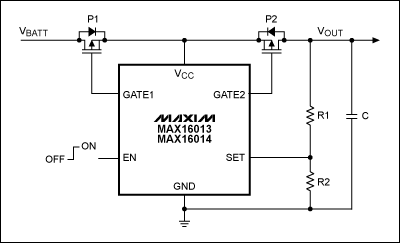
Figure 8. The MAX16013 and MAX16014 can provide active transient protection and directly monitor the power supply voltage. When a fault is detected, the two external p-channel FET switches are controlled to disconnect the load from the faulty power supply.
In the event of a fault, FET P2 has two different modes. In the first mode, P2 is equivalent to a simple switch, which opens the switch under overvoltage conditions to avoid damage to downstream devices caused by high voltage. In the second mode, P2 is equivalent to an adjustable transient suppressor, clamping the output voltage at the maximum allowable overvoltage point.
When the output voltage rises above the adjustable overvoltage threshold, the internal comparator pulls GATE2 up to VCC. When the monitoring voltage drops below the overvoltage threshold, the p-channel MOSFET (P2) turns on again. This processing method can stabilize the voltage within 5% of the output regulation value. When transient overvoltage occurs, the output can be stabilized. The MOSFET (P2) remains on under overvoltage conditions and works in the switch-linear voltage regulation mode, thereby providing overvoltage protection while maintaining system operation.
Connect the voltage divider of the SET pin to the input or output to select the corresponding operating mode. For example, by connecting a voltage-dividing resistor to VCC (instead of a load), the MAX16013 is configured as an overvoltage shutdown device. The MAX16014 will keep the MOSFET (P2) locked until the input power is re-powered or EN is re-triggered. If the MAX16013 works in voltage-limiting mode for a long time, the voltage drop of the external MOSFET will increase power consumption.
The battery reverse connection protection FET (P1, optional) in FIG. 8 replaces the series diode in FIG. 6. In Figure 8, P1 is turned on when it is positively biased, which can keep the extremely low forward voltage drop and turned off when negative pressure occurs. Turn off P2 to disconnect the input and output (Figure 8 and Figure 9), the EN pin provides the corresponding shutdown control (note that the control signal of the EN pin is generated by other monitoring circuits of the main system). Therefore, when the circuit is in reverse battery protection (P1), the quiescent current of the downstream circuit can be reduced to a minimum (typical value <20µA).
Active overvoltage protectors have the following advantages.
As mentioned above, the breakdown voltage of a discrete transient suppressor (TVS tube or variable resistor) needs to be higher than the highest steady-state operating voltage of the car (usually around 26V). When a load dump occurs, due to the internal resistance of the TVS tube and the VI characteristic curve in which the current increases dramatically with the voltage, the downstream circuit will withstand extremely high voltage (about 45V) in an instant, thereby increasing the requirements for the rated voltage of downstream devices. Unlike traditional solutions, the active transient protector can clamp the output voltage to the level set by the voltage divider (for example, 26V), and there is no problem that the current increases sharply with the voltage. These features allow users to use low-cost (low voltage) downstream components.
This scheme is different from ordinary surge suppressors. The traditional scheme can only handle a few joules of energy in a short time before overheating occurs. The scheme based on the MAX16013 / MAX16014 can protect the device when DC overvoltage occurs. Some applications require working at the upper limit of the nominal voltage. Once the upper limit voltage is exceeded, the connection to the power supply is disconnected (in the case of audio systems, the upper limit of the operating voltage is usually 17V). In this case, the use of active protection devices, reasonable setting of voltage limiter / switch threshold can further reduce the cost of downstream components.
Replacing the battery reverse diode with FET can reduce the forward voltage to millivolt level. Especially in high-current applications, this measure can effectively reduce power consumption, thereby reducing the design difficulty and cost of heat dissipation. It turns out that the power (voltage) consumed by the diode can be supplied to the load (such as a speaker) instead of being consumed by the diode, thereby improving the output power (system performance). Some applications require operating at a lower battery voltage (for example, when a car is cold-started), and also require reverse battery protection. The use of active protection devices can minimize the voltage drop and ensure that the circuit operates at a lower input voltage.
Variable resistors tend to exhibit relatively high quiescent current and leakage current, which will significantly affect their service life and accuracy when impacted by pulse voltage. Replacing variable resistors with active protection devices can solve this problem. Since the variable resistor is directly connected to the battery in some applications, the leakage current is large. At this time, you can use the active protection device as the main switch to disconnect (via the P2 FET) all subsequent loads in sleep mode (Figure 9). 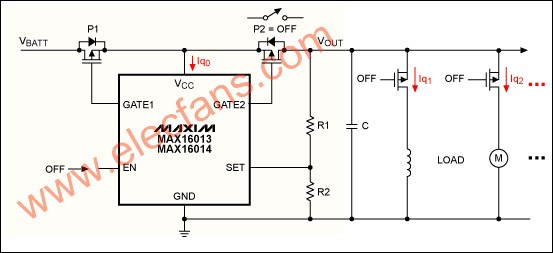
Figure 9. The MAX16013 / MAX16014 are used as the main switch control to help reduce quiescent current consumption when the ECU is turned off.
Active overvoltage protectors occupy certain advantages in many applications. These devices can greatly reduce system power consumption, increase output power (improve system performance), reduce system operating voltage (cold start), and have a lower quiescent current , Which reduces the rated voltage requirements of the subsequent protected circuit.
¹Related devices: MAX6397 / MAX6398 / MAX6399, MAX6495–MAX6499.
MAX6397 / MAX6398 / MAX6399 pdf: http: //
Low smoke zero halogen flame retardant wire refers to cable that does not contain halogen(F, Cl, Br, At). Its jacket is made up of some very special materials which are non-halogenated and flame retardant, emitting limited smoke and no halogen when exposed to high sources of heat. It can have various levels of flame retardancy and mechanical strength. The flame retardant performance of the cable is superior, very little smoke during burning, no corrosive gas escape, thereby protecting public health and avoiding any possible damage to electronic equipment. For this reason, its use is highly recommended for public places and for all installations where it is necessary avoid to electric interference of nearby circuits.
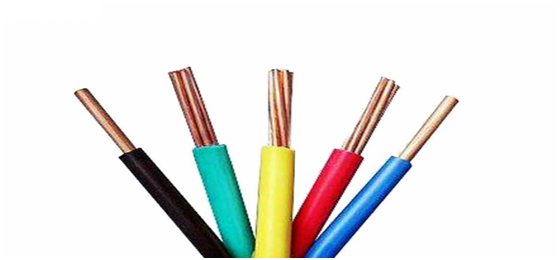
Advantages:
- Large tensile strength
- Good weatherability
- Non moving performance
- Good softness
- No toxic smoke during burning
- Excellent elasticity and stickiness
- Great resistance
- Easy installation
- Long life span
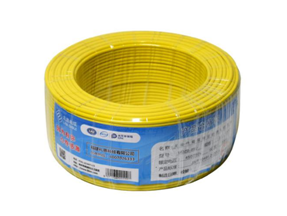

Rated Voltage:
450/750V
Application:
Wiring in all installations where fire safety is of utmost importance like schools, theaters, commercial complexes, apartments, high rise buildings, laboratories, etc.
Welcome to visit our factory to learn more about us. If you have any questions, please feel free to contact us.
LSZH Flame Retardant Wire,Flame Retardant Electric Wire,Fire Retardant Cable,LSZH Sheath Flame Retardant
Smartell Technology Co.,Ltd , http://www.liencable.com